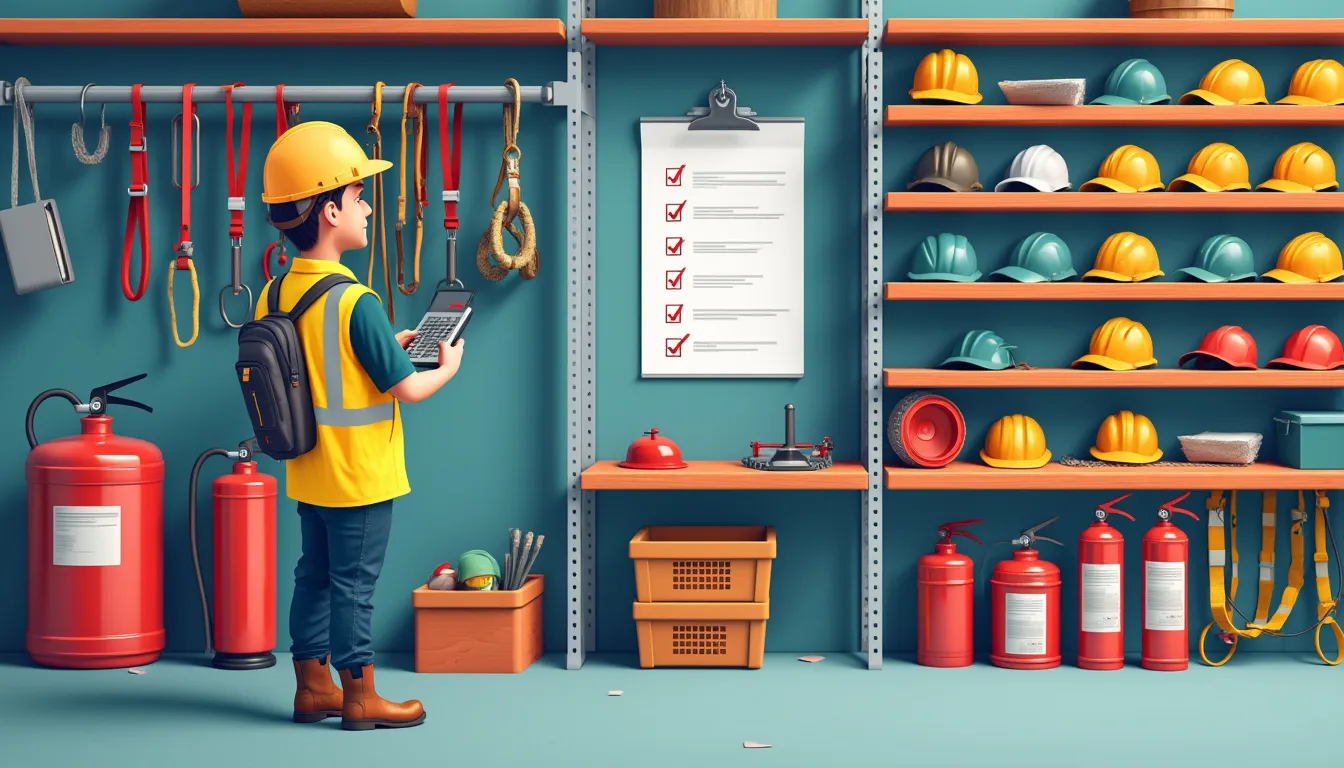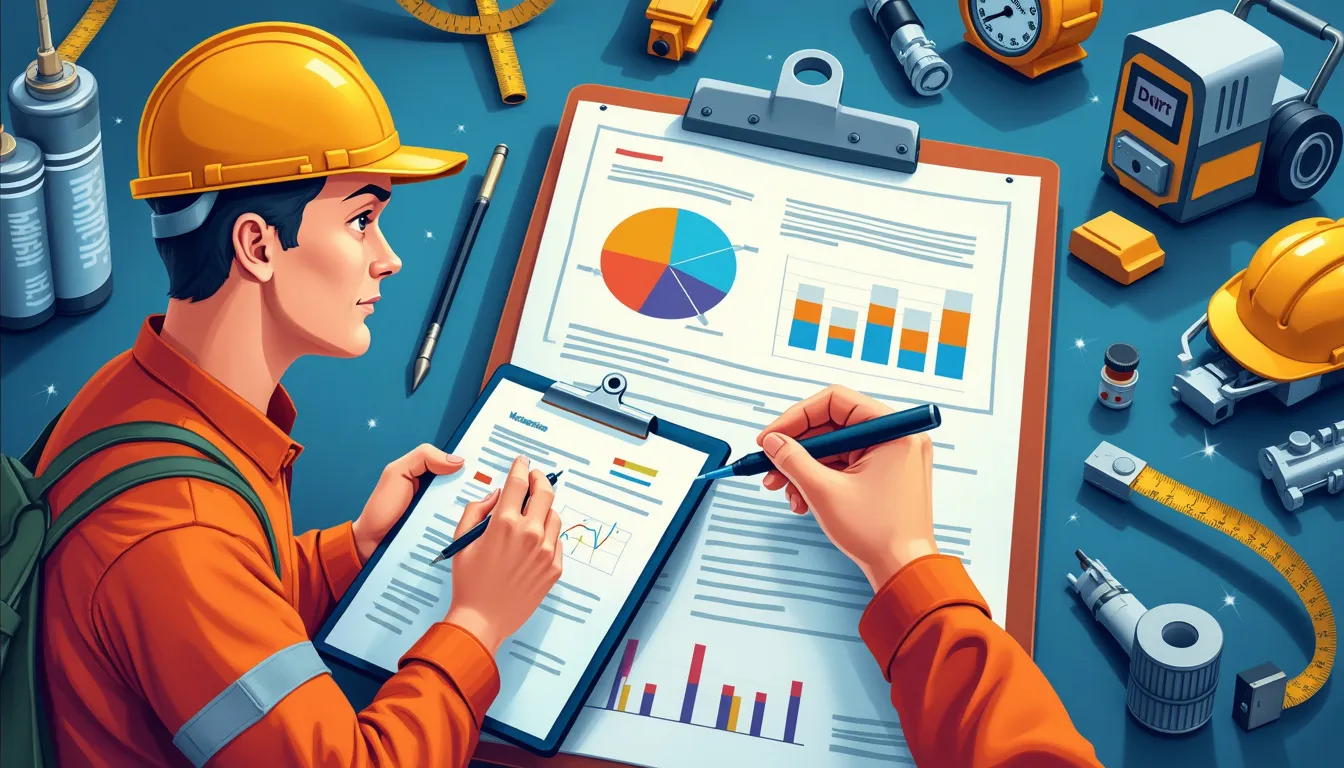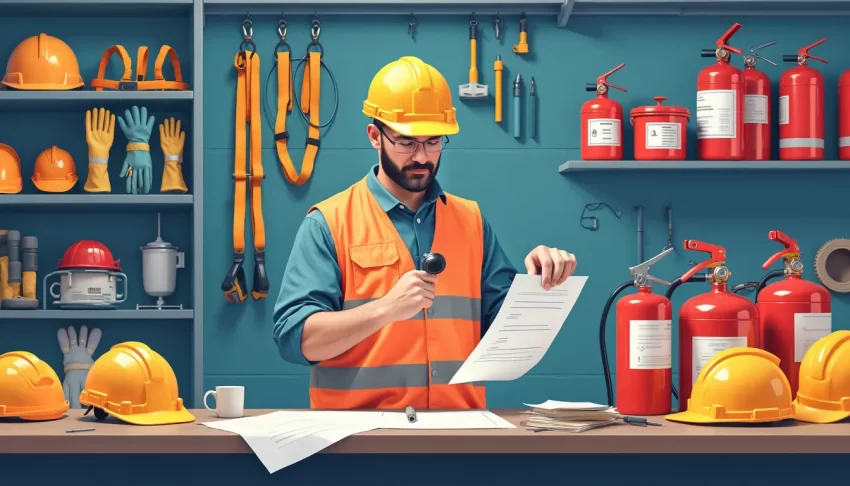In the bustling realm of workplace safety, the term safety equipment inspection might not make headlines, but it undoubtedly plays a starring role behind the scenes. Imagine a well-oiled machine where every cog and component functions seamlessly—such is the essence of conducting regular safety equipment inspections. These crucial assessments help ensure that the protective gears, emergency response tools, and fire safety apparatuses you rely on daily are in pristine working condition. From your hard hats and gloves to the fire extinguishers and first-aid kits, each piece of equipment stands as a sentinel guarding against hazards.
Yet, why is it so crucial to maintain a routine inspection schedule, you ask? The answer lies in the threefold benefits this practice yields. First, it fortifies the bedrock of your safety standards, assuring that no tool falls short in the moment of need. Second, it mitigates the risk of workplace incidents by preemptively identifying potential failures. Third, it ensures compliance with industry regulations, which can spare you from hefty fines and reputational damage.
Embark on this comprehensive journey through our Essential Guide to Safety Equipment Inspection, where we provide a thorough checklist for evaluating various types of safety gear. We’ll also share best practices to streamline your inspection process, enhance your team’s expertise, and leverage technology for greater efficiency. Your pathway to a safer, compliant, and more productive work environment starts here.
Introduction to Safety Equipment Inspection
Importance of Conducting Regular Safety Equipment Inspections
In the intricate web of workplace safety, safety equipment inspection emerges as a cornerstone. Regular inspections not only ensure compliance with regulatory requirements but also fortify the very foundation of workplace safety culture. Neglecting routine checks can lead to malfunctioning equipment when you need it most, turning minor hazards into major catastrophes.
Consider this: timely inspections identify wear and tear before they escalate into failures. By catching issues early, organizations can mitigate risks and save on potential hefty fines. A structured inspection routine is not merely an operational formality; it is a critical safeguard for employee well-being and operational continuity.
Overview of Common Safety Equipment Needing Inspection
To effectively bolster safety, it’s imperative to recognize the diverse array of equipment that necessitates regular scrutiny. Here’s a snapshot of the common categories:
- Personal Protective Equipment (PPE): Regularly inspect helmets, gloves, safety goggles, and respirators to ensure integrity and functionality.
- Fire Safety Equipment: Fire extinguishers, alarms, sprinklers, and evacuation maps require checks to ensure readiness during emergencies.
- Emergency Response Gear: First aid kits, emergency lighting, evacuation chairs, and spill containment kits must be in optimal condition for swift action.
- Machinery Safeguards: Machine guards, light curtains, and emergency stop buttons may seem robust but need regular inspection to remain effective.
The breadth of safety equipment is vast, and missing any single piece can compromise the entire safety apparatus. Systematic inspections of each item are essential to maintain a secure working environment.
Key Benefits of Maintaining Safety Standards
Up-to-date safety standards do more than just tick a compliance checkbox; they bring about a multitude of tangible benefits:
- Preventing Accidents: By ensuring all equipment functions correctly, the likelihood of accidents and injuries is significantly reduced, fostering a safer environment.
- Boosting Morale: Employees working in a well-maintained, safe environment are more confident, focused, and productive. This sense of security can translate into a higher level of job satisfaction and team cohesion.
- Cost Efficiency: Proactive maintenance and early problem detection can stave off costly repairs and potential legal liabilities. An ounce of prevention is worth a pound of cure.
- Enhancing Reputation: A commitment to safety boosts an organization’s reputation as a responsible employer and business partner. This can be a pivotal factor in attracting top talent and forging robust business alliances.
The importance of safety equipment inspection cannot be overstated. It is the linchpin that holds together the broader framework of occupational safety and operational excellence. By embracing regular inspections, organizations are not just meeting standards—they are paving the way for sustained success and resilience.
Safetyology – Get The Book Today!

Checklist for Safety Equipment Inspection
Safety equipment inspection is your frontline defense in mitigating workplace hazards. Ensuring your gear is in peak condition can mean the difference between a near miss and a serious injury. Here’s an optimized checklist designed for a thorough and efficient safety equipment inspection:
Step-by-Step Guide for Inspecting Personal Protective Equipment (PPE)
Personal Protective Equipment (PPE) is essential for safeguarding workers from potential hazards. Regular inspections are crucial. Follow these steps for an effective PPE inspection:
- Visual Inspection: Check for any visible signs of damage such as cuts, tears, or discoloration. PPE that looks compromised often is.
- Functionality Checks: Ensure that all safety mechanisms, such as helmet straps, goggle seals, and gloves’ grip, are fully operational. Non-functioning gear is a liability.
- Sizing and Fit: Verify that the equipment fits the user properly. Ill-fitting PPE can fail to provide adequate protection.
- Expiration Dates: Note the expiration dates on items like respirators and gloves, and replace any outdated equipment.
Detailed Procedures for Checking Fire Safety Equipment
Fire safety equipment is critical for early detection and response. Here’s how to ensure your fire safety gear is always ready:
- Fire Extinguishers: Inspect the pressure gauge, ensuring the needle is in the green zone. Check the condition of the hose and ensure the safety pin is intact and secured.
- Smoke Alarms: Test smoke alarms monthly by pressing the test button until you hear the alarm sound. Replace batteries annually and the entire unit every 10 years.
- Sprinkler Systems: Conduct regular flow tests to ensure there’s no blockage in the pipelines. Inspect for leaks and corrosion on a quarterly basis.
- Fire Doors and Exits: Verify that fire doors close properly and that emergency exits are accessible and free of obstructions. Test panic bars and door latches monthly.
Inspecting Emergency Response Gear Effectively
Emergency response gear needs to be inspected with meticulous care as it becomes crucial in high-stakes situations:
- First Aid Kits: Regularly inventory first aid kits, checking for expired or missing items. Include necessities like bandages, antiseptics, and CPR masks.
- Eye Wash Stations and Showers: Activate weekly to ensure proper water flow and check for any signs of rust or blockage. Maintain a clear path to all eye wash stations and showers.
- Respiratory Equipment: Perform fit tests for respirators annually and inspect for any damage to the facepiece or straps. Clean and sanitize after each use.
- Defibrillators (AEDs): Check that the device is in standby mode with all indicator lights functioning. Confirming battery and pad expiration dates is a must; replace as needed.
By following this comprehensive checklist for safety equipment inspection, you ensure a workplace that’s not only compliant with standards but also genuinely safe for all employees. Regular and thorough inspections prevent equipment failure and enhance overall workplace safety. Doing so reflects a commitment to the highest safety standards, instilling confidence with every proactive step taken.
Safetyology – Get The Book Today!

Best Practices for Conducting Safety Equipment Inspection
Consistency is key in maintaining the standards of safety equipment inspection. In this section, we dive into the best practices that ensure your safety equipment remains in peak condition, safeguarding your workplace from potential hazards.
Setting Up a Regular Inspection Schedule
A well-defined and consistently adhered-to inspection schedule forms the backbone of effective safety equipment management. Regularly scheduled inspections prevent the oversight of crucial details and ensure that all equipment is checked within appropriate intervals. Common timelines for safety equipment inspections can vary from daily, weekly to monthly, depending on the specific gear and regulatory requirements.
Optimizing the Inspection Timeline:
- Daily Inspections: Ideal for high-use equipment like Personal Protective Equipment (PPE) which includes helmets, gloves, and eye protection.
- Weekly Inspections: Suitable for fire safety equipment, such as extinguishers and smoke detectors, ensuring they are always in operational condition.
- Monthly Inspections: Best for emergency response gear, ensuring readiness without causing over-inspection wear and tear.
Adhering to a regular schedule not only keeps equipment functional but also complies with OSHA regulations and standards. Automation tools and digital reminders can aid in upholding these schedules, reducing human error.[/p]
Training Staff on Proper Inspection Techniques
Empowering your staff with comprehensive training on safety equipment inspection translates into higher efficiency and reliability. Untrained personnel might miss critical faults or perform superficial checks, compromising safety.
Essential Training Components:
- Hands-On Workshops: Conduct practical sessions where employees can practice inspection processes under expert supervision.
- Instructional Materials: Distribute detailed manuals and guides that staff can reference at any time.
- Regular Refresher Courses: Schedule periodic training updates to keep staff abreast of new safety standards and inspection techniques.
Investing in thorough training enhances the overall efficacy of your safety equipment inspections, ultimately safeguarding all employees.
Utilizing Technology for Efficient Inspections
Embracing technology can revolutionize the way safety equipment inspections are conducted. Digital tools not only streamline the inspection process but also ensure accuracy and accountability.
Technological Solutions for Inspection:
- Inspection Software: Provides digital checklists, automates scheduling, and ensures comprehensive recording of inspection details.
- Mobile Apps: Enable instant data logging and photo documentation, making inspections more efficient and reducing paperwork.
- Barcode Scanners and RFID Tags: These tools track equipment usage and maintenance records, ensuring accurate lifecycle management.
Modern technology solutions not only save time but also enhance the precision of inspections. They ensure that critical safety issues are flagged and addressed promptly, maintaining a safe working environment.
Incorporating these best practices for conducting safety equipment inspections positions your organization to meet the highest safety standards, fostering a secure workplace for all.
Safetyology – Get The Book Today!

Reporting and Addressing Inspection Findings
Documenting Inspection Results Accurately
A meticulous and transparent process of recording inspection findings is the cornerstone of effective safety equipment inspection. Every detail matters; from minor wear to significant flaws, each observation should be noted promptly and clearly. This not only ensures accountability but also serves as a reference for future inspections, creating a historical record that helps in identifying patterns or recurring issues. Accurate documentation includes the date of inspection, the specific equipment inspected, the condition reported, and any immediate actions taken.
Using standardized forms and checklists can significantly streamline this process. Digital tools and software solutions offer dynamic options for logging findings instantly, reducing the possibility of human error and facilitating easy access and storage. By adopting such methods, companies can ensure consistency, reliability, and efficiency in their reporting practices.
Addressing and Rectifying Issues Discovered During Inspections
Identifying issues during a safety equipment inspection is just the beginning; addressing these issues promptly and effectively is where true safety management shines. Immediate attention should be given to any red-flag findings that pose an immediate risk to safety. Such issues should be escalated to the proper authorities or maintenance teams without delay.
Creating a clear action plan for rectifying these issues is crucial. This involves delineating responsibilities, setting deadlines, and ensuring that all necessary resources are available. For complex or critical problems, a multi-disciplinary team approach can be beneficial, leveraging the expertise of various stakeholders to develop a comprehensive solution.
Furthermore, it’s essential to follow up on the remedial actions taken. Conducting re-inspections to verify that issues have been resolved effectively ensures that the safety standards are not just compliance items on a checklist but are ingrained in the operational ethos of the organization.
Ensuring Ongoing Compliance and Safety Standards
Maintaining ongoing compliance with safety regulations and standards is not merely about passing inspections but fostering a culture of safety within the organization. Staying updated with the latest industry regulations, standards, and best practices is paramount. Regularly revisiting and revising safety protocols ensures alignment with legislative changes and industry advancements.
Engagement is key to sustaining a safety-first mindset. Conducting routine training sessions, workshops, and refresher courses for employees helps in keeping everyone informed and vigilant. Moreover, fostering an environment where employees feel empowered to report discrepancies or potential hazards without fear of retribution can significantly enhance proactive safety measures.
The integration of technology plays a critical role here. Leveraging IoT devices, AI-driven analytics, and real-time monitoring systems not only aids in immediate detection of anomalies but also ensures continuous surveillance and compliance without human oversight. This leap towards a digital safety infrastructure can dramatically uplift an organization’s adherence to safety protocols.
Finally, externally auditing the inspection processes periodically provides an independent evaluation of the efficacy and robustness of the safety programs. Such audits can unearth areas for improvement that might be overlooked internally, guiding the organization towards a more fortified safety framework.
In conclusion, a structured process for documenting, addressing, and ensuring continuous compliance with safety equipment inspections prevents lapses that could lead to dire consequences. By embedding these practices into the daily operations, organizations not only safeguard their assets and personnel but also fortify their commitment to a culture of uncompromising safety.
In wrapping up our guide on safety equipment inspection, it’s apparent that maintaining a rigorous inspection protocol isn’t just recommended, but essential. Regular safety equipment inspections are the backbone of a secure workplace, safeguarding not just assets but the irreplaceable human lives that enhance organizational value. From personal protective equipment to fire safety apparatus and emergency response gear, ensuring each piece is functional and compliant stands as a testament to a company’s commitment to safety.
Implementing a detailed checklist ensures nothing is overlooked, providing a structured, step-by-step pathway to thorough evaluations. Regular inspections aren’t sufficient by themselves; staff must be trained in precise inspection techniques to catch those hard-to-spot issues that could escalate into significant hazards. Moreover, leveraging technology can streamline these processes, turning a traditionally cumbersome task into an efficient routine.
Beyond just inspecting, documenting your findings meticulously and swiftly addressing any discovered deficiencies are critical. This not only ensures regulatory compliance but fosters a culture of continuous improvement and heightened safety awareness.
Ultimately, the advantages of adhering to impeccable safety standards are manifold: reduced workplace accidents, fewer operational interruptions, and enhanced morale among a workforce confident in their well-being. Safety equipment inspection, undertaken with diligence and regularity, anchors these benefits, safeguarding both the present and the future of any enterprise.
Safetyology – Get The Book Today!
Support Us: Check out our recommended products on Amazon.

